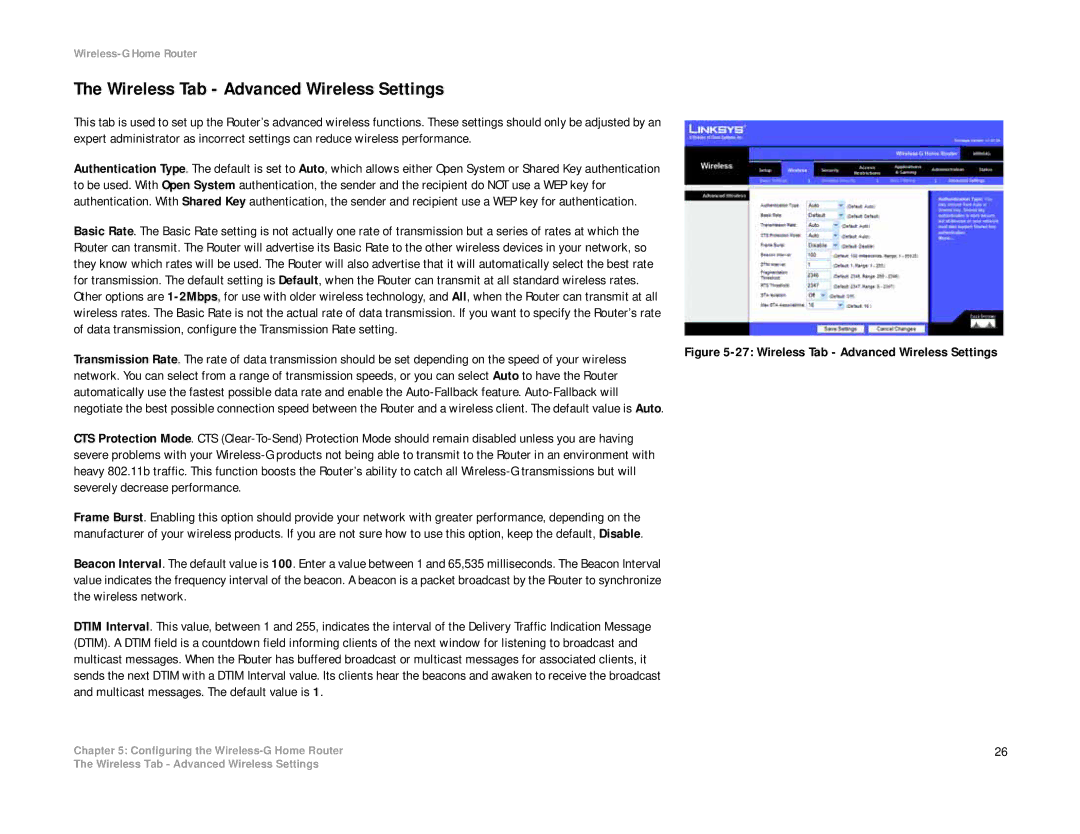
Wireless-G Home Router
The Wireless Tab - Advanced Wireless Settings
This tab is used to set up the Router’s advanced wireless functions. These settings should only be adjusted by an expert administrator as incorrect settings can reduce wireless performance.
Authentication Type. The default is set to Auto, which allows either Open System or Shared Key authentication to be used. With Open System authentication, the sender and the recipient do NOT use a WEP key for authentication. With Shared Key authentication, the sender and recipient use a WEP key for authentication.
Basic Rate. The Basic Rate setting is not actually one rate of transmission but a series of rates at which the Router can transmit. The Router will advertise its Basic Rate to the other wireless devices in your network, so they know which rates will be used. The Router will also advertise that it will automatically select the best rate for transmission. The default setting is Default, when the Router can transmit at all standard wireless rates. Other options are
Transmission Rate. The rate of data transmission should be set depending on the speed of your wireless | Figure |
| |
network. You can select from a range of transmission speeds, or you can select Auto to have the Router |
|
automatically use the fastest possible data rate and enable the |
|
negotiate the best possible connection speed between the Router and a wireless client. The default value is Auto. |
|
CTS Protection Mode. CTS |
|
severe problems with your |
|
heavy 802.11b traffic. This function boosts the Router’s ability to catch all |
|
severely decrease performance. |
|
Frame Burst. Enabling this option should provide your network with greater performance, depending on the |
|
manufacturer of your wireless products. If you are not sure how to use this option, keep the default, Disable. |
|
Beacon Interval. The default value is 100. Enter a value between 1 and 65,535 milliseconds. The Beacon Interval |
|
value indicates the frequency interval of the beacon. A beacon is a packet broadcast by the Router to synchronize |
|
the wireless network. |
|
DTIM Interval. This value, between 1 and 255, indicates the interval of the Delivery Traffic Indication Message |
|
(DTIM). A DTIM field is a countdown field informing clients of the next window for listening to broadcast and |
|
multicast messages. When the Router has buffered broadcast or multicast messages for associated clients, it |
|
sends the next DTIM with a DTIM Interval value. Its clients hear the beacons and awaken to receive the broadcast |
|
and multicast messages. The default value is 1. |
|
Chapter 5: Configuring the | 26 |
The Wireless Tab - Advanced Wireless Settings
